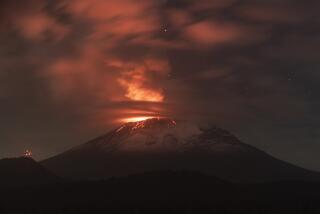Growing old in Andean town has its advantages
- Share via
VILCABAMBA, ECUADOR — Interrupted during his morning walk, Manuel Picoita, 102, stopped to answer the question every visitor to this remote corner of the Andes asks: How do he and other residents live so long?
“I get along with my neighbors,” Picoita said with a smile. “There is tranquillity and solidarity among us.”
For Josefa Ocampo, 104, who lives with her son up the road a bit from Picoita, the secret is drinking a glass of goat’s milk every morning, sometimes supplemented with a dose of her first morning urine. She says it keeps her stomach settled and skin clear.
Aurora Maza, now half-blind and confined mostly to a chair, said working the fields until she was 96 kept her fit. “Then I fell and hurt myself and had to stop,” the 102-year-old said.
Scientists, journalists and health enthusiasts have been coming to Vilcabamba for half a century in search of clues to what makes this out-of-the-way town so conducive to long life.
A scientific study decades ago found that nearly 15% of the residents lived past 60, compared with 4.5% in the rest of the country. Clean air, a mild climate, mineral-rich water, low-calorie diets and active work and sex lives are the factors most often cited.
But are fewer Vilcabambans reaching the magic 100 number these days?
That’s the fear in this town of 4,500 that has built a reputation and a thriving health-based tourist trade on its residents’ longevity. The number of people 100 or older has dropped to five from 10 to 12 in 2000, town official Victor Carpio said. The town has lost four centenarians this year.
Wilson Pilco, a doctor who has seen patients at the town’s health clinic for 25 years, said he had no doubt that the longevos, as the long-lived ones are called, were declining in numbers. The healthy conditions that once existed have been diminished by the encroachments and stress of modern life, he said.
“When I first came, people lived an extremely quiet, conservative way of life. They went to bed early and ate only what they produced, all natural with no pesticides or fertilizers.
“Now those habits and tranquillity have changed,” Pilco said. “Now, junk food has replaced the grains and the discotecas the tranquillity.”
Vilcabamba, which had four or five cars 15 years ago, now has dozens, said Richard Fontes, a Brazilian native who owns a health food store just off the central plaza. And land speculation driven by the arrival of wealthy foreigners and the construction of 16 inns and health spas since 1990 has created Type A personalities here.
“Everyone has taken on the foreign mind-set: land speculation, taxis and Coca-Cola,” Fontes said. “People are being ground up in the grinding machine, like hamburger.”
Rumors that mining projects may be in the works are also causing a buzz among townspeople. Crews have done test drilling for gold and other natural resources in the mountains surrounding the Vilcabamba valley. Some of the drilling has been in the shadow of the valley’s best-known landmark, a peak called Mandango, where legend has it that Incas hid huge quantities of gold from the Spanish conquistadors.
But officials at the Ministry of Mining and Energy in Quito, the Ecuadorean capital, insist that though half a dozen mining concessions have been granted in the area, there is little chance of large-scale production.
“There may be some exploring going on, but there are no indications of any productive deposits of gold,” Carlos Muiragui, the vice minister of mining and energy, said in an interview. “We’re going to take care of Vilcabamba. The old ones are not going to die because of mining.”
Although busier than before, Vilcabamba is still laid back, the climate mild, the air clean and redolent of tropical fragrances. The sweet smell is said to come from a tree called the huilco that produces copious quantities of oxygen.
The town has become a destination for people with heart conditions looking for rejuvenation, said health spa owner Zoila Aguirre, 74, who moved here 15 years ago to improve her health. “I couldn’t walk a block without losing my breath before and now take long walks every day,” she said.
Centenarians may not be out in abundance, but the number of spry, good-humored elderly people walking the streets in and around Vilcabamba seems high, though they may stand out because many of the town’s young people have left for bigger cities.
“Many times, their children take them to live in Loja to look after them,” Carpio said, speaking of the nearest city. “But the longevos feel useless there and die within a few weeks.”
More to Read
Sign up for Essential California
The most important California stories and recommendations in your inbox every morning.
You may occasionally receive promotional content from the Los Angeles Times.













